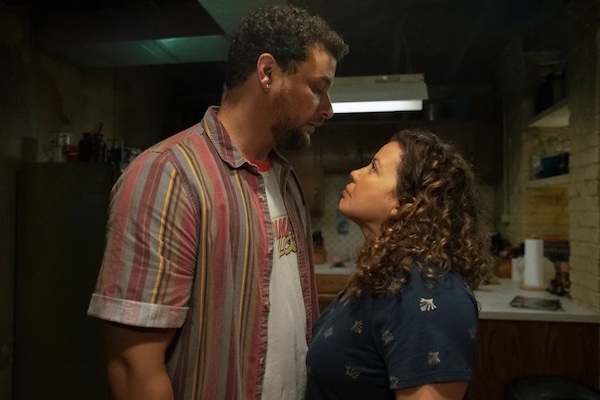Television Review: “The Horror of Dolores Roach” — The Curse of the Magic Hands
By Sarah Osman
The Horror of Dolores Roach is a captivating mixture of horror, suspense, and comedy that proves we haven’t come all that far from the class-fueled injustices of Victorian England.

A scene from The Horror of Dolores Roach. Photo: Prime Video
While Sweeney Todd: The Demon Barber of Fleet Street is arguably one of Stephen Sondheim’s best musicals, the character was not Sondheim’s own creation. Todd first appeared as the villain of a 1846 penny dreadful serial The String of Pearls. The original Sweeney and Sondheim’s version shared parallels: both are barbers who murder their victims with a straight razor. The killer is then assisted by Mrs. Lovett, who bakes their remains into her pies. Christopher Bond’s play Sweeney Todd gave Sweeney a sympathetic backstory: he had been exiled (unjustly so) to Australia by a cruel judge, who then raped Todd’s wife. Sweeney Todd is primarily about the futility of revenge, but the musical also focuses on corruption, moral and political. There were no safety nets for the poor in Victorian England so they were forced into immoral behavior in order to survive (granted, Sweeney Todd takes this to extremes). No one in the musical fares well — while the greed and selfishness of the rich emerges relatively untouched.
Sweeney Todd was a historical drama, but its themes, particularly the pressures on the poor, remain au courant. Initially a one-woman show that became a podcast and now a TV series, The Horror of Dolores Roach adapts Sweeney Todd for the New York of today. The result is a captivating mixture of horror, suspense, and comedy that proves we haven’t come all that far from the class-fueled injustices of Victorian England. Starring Justina Machado as the titular character, the series revolves around a woman who once had been the girlfriend of a successful weed dealer in post-9-11 Washington Heights. After she is caught, Dolores spends 16 years in prison, where she learns how to give massages from her amputee roommate. (Among its other virtues, The Horror of Dolores Roach is delightfully weird.) Upon release, she returns to a now-gentrified Washington Heights, her ex nowhere to be found. A stoner buddy, and the owner of a failing empanada shop, Luis (Alejandro Hernandez), takes Dolores in and helps her start up a business. Dolores gives massages with her magic hands. However, a nosy landlord comes searching for the back rent and Dolores takes matters into her own, in this case deadly, hands. The result: empanadas stuffed with tidbits of the landlord.
Much of the show’s brilliance is powered by Machado’s performance. One of the most critically underappreciated actresses of the last 20 years, Machado transforms the desperate Dolores into a surprisingly sympathetic heroine. Unlike Todd, who’s typically played as a madman, Dolores is a convincingly “sane” serial killer. She’s not hell-bent on revenge, at least at the start. Dolores simply wants to rebuild her life, and Machado complicates this desire for normality by vacillating between several emotions, sometimes all in the same scene. While Machado is undeniably the star, several fine actors pop up, and they supply plenty of spice to the series. The series boasts Marc Maron, Jean Yoon, Judy Reyes (in a complete 180 from her role on Claws), and Cyndi Lauper.
The pacing of each episode moves along briskly, keeping the tension high. Unlike series whose episodes drag on past the 45-60 minute mark, each installment in The Horror of Dolores Roach is a quickfire 25-30 minutes. At eight episodes, the drama assumes the tempo of a play, which makes sense, given the series’ source material. Each installment neatly builds up to the next, leading to the perfect climax. It’s a master class in efficient storytelling that other showrunners should take note of.
Like the now classic musical from which it drew its inspiration, The Horror of Dolores Roach is gruesome. But the violence never comes off as gratuitous because it focuses on Dolores’s increasingly horrifying no-win dilemma. Yes, cannibalism is over-the-top, but the protagonist’s plight in a hostile society is all too real. Ex-convicts like Dolores, even after they’ve served their time, struggle to find work and establish a stable home. They are not anxious to return to prison. No need to go into the economic/social obstacles to success — beginning with gentrification. There is no single corrupt judge in the series, the way there is in Sweeney Todd. The entire system is messed up, and Dolores Roach is simply one more victim.
Sarah Mina Osman is a writer residing in Wilmington, NC. In addition to writing for the Arts Fuse, she has written for Watercooler HQ, Huffington Post, HelloGiggles, Young Hollywood, and Matador Network, among other sites. Her work was included in the anthology Fury: Women’s Lived Experiences in the Trump Era. She is currently a first year fiction MFA candidate at the University of North Carolina Wilmington. When she’s not writing, she’s dancing, watching movies, traveling, or eating. She has a deep appreciation for sloths and tacos. You can keep up with her on Twitter and Instagram: @SarahMinaOsman
